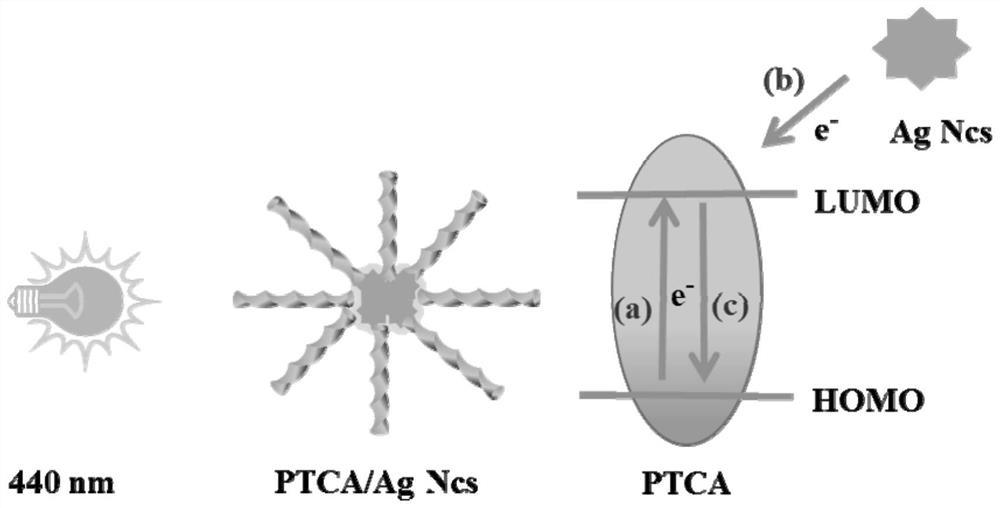Preparation method and application of fluorescent biosensor for detecting transgenic protein
A biosensor and transgenic technology, applied in the field of preparation of fluorescent biosensors, can solve problems such as low sensitivity, and achieve the effects of high sensitivity, easy operation and low experimental cost
- Summary
- Abstract
- Description
- Claims
- Application Information
AI Technical Summary
Problems solved by technology
Method used
Image
Examples
specific Embodiment 1
[0032] A method for preparing a fluorescent biosensor for detecting transgenic proteins, such as figure 1 shown, including the following steps:
[0033] (1) Synthesis of 3,4,9,10-perylenetetracarboxylic acid (PTCA)
[0034] Add 9 mg of 3,4,9,10 perylenetetracarboxylic dianhydride (PTCDA) to 11 mL of 1 mol / L NaOH solution, sonicate at an ultrasonic frequency of 90 kHz for 15 min, and then heat the solution until PTCDA is completely Dissolve, after the solution color turns yellow-green, add 1 mol / L HCl solution in the solution until the mixture color turns red completely, centrifuge and wash, and wash the collected precipitate alternately with absolute ethanol and ultrapure water, that is, The PTCA precipitate was obtained, dried in vacuum at 40°C for 3 hours, and dispersed in ultrapure water;
[0035] (2) Synthesis of silver nanoclusters
[0036]Add 4.3 mg of lipoic acid powder to 2.0 mL of ultrapure water, then add 0.012 mL of sodium borohydride solution with a concentratio...
Embodiment 2
[0042] Same as above-mentioned Example 1, the difference is: in the synthesis of step (1) 3,4,9,10-perylenetetracarboxylic acid (PTCA): 8mg 3,4,9,10 perylenetetracarboxylic dianhydride (PTCDA ) was added to 10 mL of NaOH solution with a concentration of 1 mol / L, and sonicated at an ultrasonic frequency of 80 kHz for 15 min; step (2) in the synthesis of silver nanoclusters: 4.2 mg of lipoic acid powder was added to 2.0 mL of ultrapure water , then add 0.01 mL of sodium borohydride solution with a concentration of 2 mol / L, and after stirring vigorously for 30 min, the solution becomes clear and transparent, then slowly add 0.04 mL of a concentration of 0.05 mol / L silver nitrate solution and 0.03 Sodium borohydride solution with a concentration of 2 mol / L in mL, continued to react for 90 minutes and then stopped stirring to obtain a silver nanocluster solution, which was stored in a refrigerator at 4°C for more than 24 hours.
Embodiment 3
[0044] Same as above-mentioned Example 1, the difference is: in the synthesis of step (1) 3,4,9,10-perylenetetracarboxylic acid (PTCA): 10mg 3,4,9,10 perylenetetracarboxylic dianhydride (PTCDA ) was added to 12 mL of NaOH solution with a concentration of 1 mol / L, and sonicated at an ultrasonic frequency of 100 kHz for 15 min; step (2) in the synthesis of silver nanoclusters: 4.5 mg of lipoic acid powder was added to 2.0 mL of ultrapure water , then add 0.015mL of sodium borohydride solution with a concentration of 2 mol / L, and after stirring vigorously for 30 min, the solution becomes clear and transparent, then slowly add 0.05mL of a concentration of 0.05mol / L silver nitrate solution and 0.04 Sodium borohydride solution with a concentration of 2 mol / L in mL, continued to react for 90 minutes and then stopped stirring to obtain a silver nanocluster solution, which was stored in a refrigerator at 4°C for more than 24 hours.
PUM
| Property | Measurement | Unit |
|---|---|---|
| molecular weight | aaaaa | aaaaa |
Abstract
Description
Claims
Application Information
 Login to View More
Login to View More - R&D
- Intellectual Property
- Life Sciences
- Materials
- Tech Scout
- Unparalleled Data Quality
- Higher Quality Content
- 60% Fewer Hallucinations
Browse by: Latest US Patents, China's latest patents, Technical Efficacy Thesaurus, Application Domain, Technology Topic, Popular Technical Reports.
© 2025 PatSnap. All rights reserved.Legal|Privacy policy|Modern Slavery Act Transparency Statement|Sitemap|About US| Contact US: help@patsnap.com



